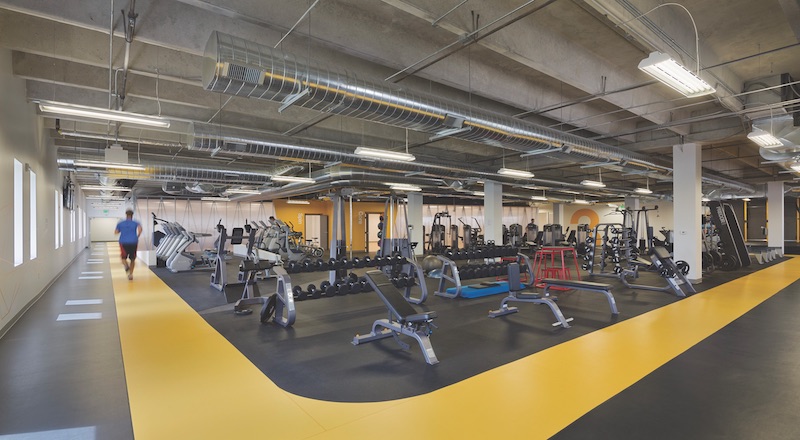Five years ago, 3form, a materials manufacturer, did a top-to-bottom remodel of its Salt Lake City headquarters campus that included adding a 14,500-sf gym, which was built with the company’s sustainable building products.
3form also instituted a policy that employees who used the gym and complied with certain health metrics would qualify for discounts on their monthly payroll contributions for healthcare coverage. In December 2018, 3form had saved so much money on healthcare costs as a result of this program that it was able to offer its employers free coverage for that month.
The savings equaled 8.3% of the workers’ gross pay in December.
Talley Goodson and Wynn Clayton, 3form’s CEO and CFO, “saw that something was happening on the horizon” about increasing healthcare costs when they approved the investment for the gym, says Christian Darby, the company’s Vice President of Design and Marketing. They took a “holistic approach” whose goal was to improve the overall health of 3form’s workforce, while controlling healthcare costs.
As of December the company employed 382 people and had a total of 909 covered under its healthcare plan. Family members can use the gym, which offers 24/7 access. The facility has eight contracted personal trainers whose jobs include evaluating the gym’s equipment each year for functionality and usage.
Beyond the gym, 3form provides its workers with an onsite doctors’ office for medical appointments, as well as blood tests and prescription refills. Services include follow-up care and counseling in the office or via telephone.
Darby says 3form has had the same healthcare provider for the past four years and into 2019. The company raised its employees’ payroll deduction for healthcare by only 3% in 2018—compared to the national average of 10-12%—and is not increasing that deduction for coverage in 2019.
Darby says participating employees are required to check in with the company’s clinic four times a year, during which 3form’s medical staff might suggest health “opportunities” for employees or their family members to pursue.
To get the discounts on premiums, employees must participate in a Health Risk Assessment to see if they fall outside of established standards for cholesterol, body mass, diabetes, asthma, hypertension, health of mind, eating habits, stress level, or tobacco use. If so, they enter a program and engage in a process that can include taking prescribed medicine or meeting with medical professionals.
In Darby’s case, the med staff found that his cholesterol was “a tad high,” he says, and established targets and a strategy to help lower it.
Related Stories
High-rise Construction | Jul 29, 2024
Safdie Architects’ Shanghai office tower features glass-enclosed corner garden that ascends the 35-story structure
Safdie Architects has announced the completion of LuOne Mixed-Use Complex—a business, retail, and entertainment development in the Luwan district of Shanghai, China. The mixed-use complex consists of an eight-level retail galleria, which opened in 2018, and a 35-story office tower, which recently reached completion.
Smart Buildings | Jul 25, 2024
A Swiss startup devises an intelligent photovoltaic façade that tracks and moves with the sun
Zurich Soft Robotics says Solskin can reduce building energy consumption by up to 80% while producing up to 40% more electricity than comparable façade systems.
Great Solutions | Jul 23, 2024
41 Great Solutions for architects, engineers, and contractors
AI ChatBots, ambient computing, floating MRIs, low-carbon cement, sunshine on demand, next-generation top-down construction. These and 35 other innovations make up our 2024 Great Solutions Report, which highlights fresh ideas and innovations from leading architecture, engineering, and construction firms.
Office Buildings | Jul 22, 2024
U.S. commercial foreclosures increased 48% in June from last year
The commercial building sector continues to be under financial pressure as foreclosures nationwide increased 48% in June compared to June 2023, according to ATTOM, a real estate data analysis firm.
Sponsored | Office Buildings | Jul 17, 2024
Unlocking Sustainability: Smart Access in the Coworking Space
Smart building technologies, including modern access control systems, are transforming coworking spaces by advancing sustainability initiatives and offering new ways to create and operate efficient working spaces. Learn more about the benefits of eco-friendly practices, from reducing carbon emissions to cutting operating costs, and discover how choosing the right partners can amplify your green efforts.
Adaptive Reuse | Jul 12, 2024
Detroit’s Michigan Central Station, centerpiece of innovation hub, opens
The recently opened Michigan Central Station in Detroit is the centerpiece of a 30-acre technology and cultural hub that will include development of urban transportation solutions. The six-year adaptive reuse project of the 640,000 sf historic station, created by the same architect as New York’s Grand Central Station, is the latest sign of a reinvigorating Detroit.
Government Buildings | Jul 8, 2024
GSA adopts new accessibility guidelines for federal properties
The U.S. General Services Administration (GSA) adopted a new rule with new accessibility guidelines for federal buildings. The rule establishes that pedestrian facilities in the public right-of-way are readily accessible to and usable by people with disabilities.
Office Buildings | Jul 8, 2024
Office vacancy peak of 22% to 28% forecasted for 2026
The work from home trend will continue to put pressure on the office real estate market, with peak vacancy of between 22% and 28% in 2026, according to a forecast by Moody’s.
Office Buildings | Jul 1, 2024
Mastering office layouts: 5 primary models for maximum efficiency and productivity
When laying out an office, there are many factors to consider. It’s important to maximize the space, but it’s equally important to make sure the design allows employees to work efficiently.
Smart Buildings | Jul 1, 2024
GSA to invest $80 million on smart building technologies at federal properties
The U.S. General Services Administration (GSA) will invest $80 million from the Inflation Reduction Act (IRA) into smart building technologies within 560 federal buildings. GSA intends to enhance operations through granular controls, expand available reporting with more advanced metering sources, and optimize the operator experience.

















